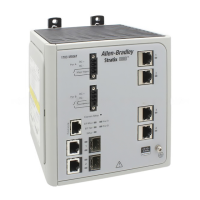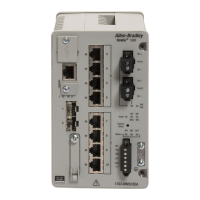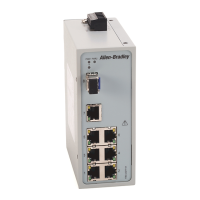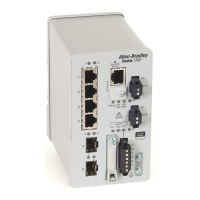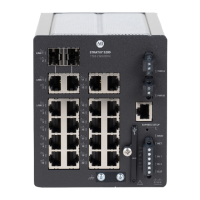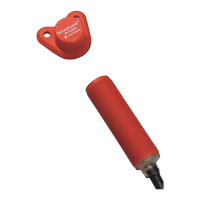Rockwell Automation Publication 1783-UM003G-EN-P - December 2012 91
Manage the Switch via the Device Manager Web Interface Chapter 3
To reduce congestion, consider segmenting the network into subnetworks that
are connected by other switches or routers. Look for other causes, such as faulty
devices or connections, that can also increase bandwidth utilization on the
switch.
Packet Error Gauge
The Packet Error gauge shows the total packet error percentage for the switch.
Each bar in the gauge represents 10% and does not show increments that are less
than 10%. The gauge does not show total packet errors under 5%.
Data is collected at each 60-second system refresh. The packet-error percentage is
calculated by comparing two values:
• The total number of packets that are sent and received
• The total number of packets with errors that are sent and received
If the packet-error percentage is high (that is, above 10%), the switch bandwidth
utilization might also be too high (a sign that the network is congested). Other
causes for packet errors are faulty cabling and port misconfigurations, such as a
Duplex mode mismatch. These problems can cause network users to experience
intermittent connectivity or loss of connectivity to the network resources (such
as servers and printers) or to the Internet. Excessive collisions can cause
transmission delays. For example, users might experience excessive delays in
sending or receiving information through the network.
The Port Statistics dialog box displays some of the types of packet errors collected
by the switch. The type of packet error can help you to identify a more precise
cause for some network problems. Refer to
Port Statistics on page 96 for more
information
.
Packet Errors
Error Description
Runt packets Packets that are smaller than the allowed minimum size (less than 64 bytes).
Giant packets Packets that are larger than the allowed maximum size (more than 1518 bytes).
Cyclic redundancy checksum
(CRC) errors
Errors generated by the originating LAN station or far-end device do not match the checksum calculated from the data
received. On a LAN, this usually means noise or transmission problems on the LAN interface or the LAN bus itself. A
high number of CRCs is usually the result of collisions or of a station sending bad data.
Overrun packets Packets that the receiving device was unable to receive.
Frame packets Packets received because of a CRC error and a noninteger number of octets. On a LAN, this is usually the result of
collisions or a malfunctioning Ethernet device.
Ignored packets Packets that the interface ignores because the interface hardware is low on internal buffers. These buffers are different
than the system buffers. Broadcast storms and bursts of noise can cause the ignored count to increase.
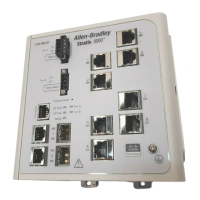
